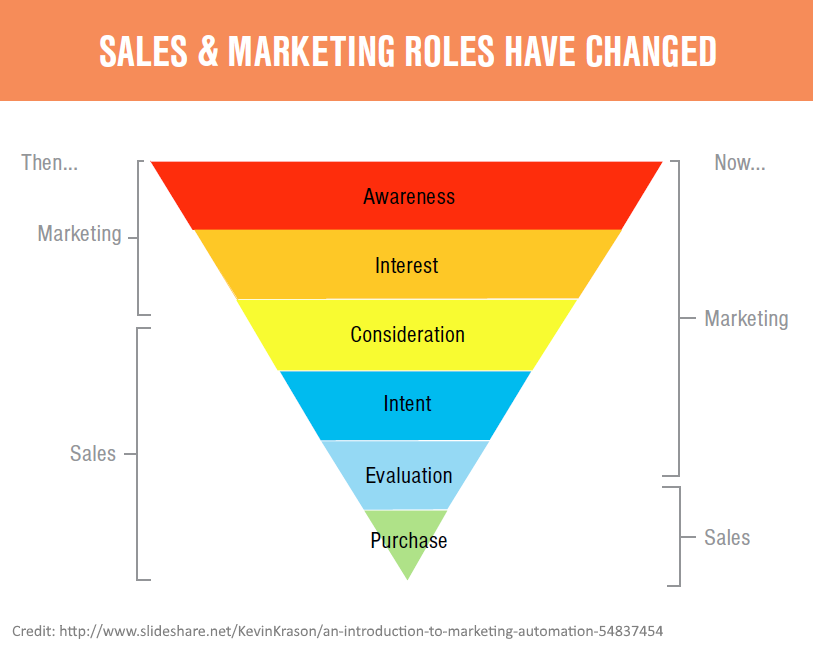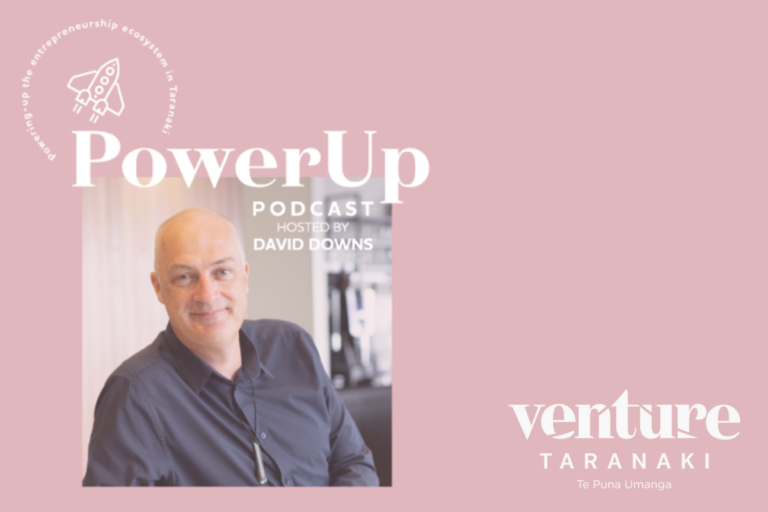Are salespeople still relevant? Part One

How have sales and marketing changed due to the Internet and technology? What is the current role of the salesperson? Are salespeople still relevant and do we still need them – or has marketing taken over?
I’ve been reflecting on these questions, ever since I saw this Slideshare infographic by Kevin Krason which shows how the salesperson’s role has changed.
On the left of the graphic, we can look back to ‘the good old days’. Back ‘then’, marketing was simply about building awareness and interest. Sales performed the next steps in the process of acquiring more customers – consideration, intent, evaluation and purchase.
On the right, the infographic says that ‘now’, marketing has taken over half of what the sales function used to be – that it now covers awareness, interest, and also consideration, intent and part of evaluation. Sales appears to just be left with part of evaluation, and purchase.
The infographic hints that sales has become an ‘order-taker’ function – and some of the online comments said exactly that.
So it got me thinking – How have sales and marketing changed? What is the current role of the salesperson in 2017? Also – where is “sales” going?
These are very big questions, and in order to do them justice this article has been broken into two parts. Here in part one, I’ll discuss how sales and marketing have changed. In part two I will discuss the role of the salesperson, and the ways we now need salespeople.
First, let’s clarify the six steps in the ‘new business development’ process
Awareness
This is where the potential customer first becomes aware of your business, and the products, and services you offer. Branding is key for this step. This is where you first tell your customer the story of who you are and how you can help them to achieve their goals.
Interest
In this second step, you are building up the potential customer’s interest in your brand. You make sure that you appear where your ideal customer is likely to be.
Consideration
This is a crucial phase. The customer has become aware of the need it has, and your business is now a contender to meet that need.
Intent
Now customers are actively looking for a solution to their problem. They know they want to make a buying decision, they may even have a deadline by which they want the solution in place for their business.
Evaluation
At this stage, the customer is evaluating the options which could provide the solution to their problem.
Purchase
The customer has finished researching and dialoguing with possible providers. The solution is chosen, the contract signed and the purchase is completed.
Clarifying sales back ‘then’
Back ‘then’, before the Internet, businesses had fairly defined places to start building awareness with customers. You could advertise in newspapers, or use radio or TV, you could sponsor a sports team. Billboards and signs were important too. A lot of this awareness-building happened with tangible items – business cards, flyers, or complimentary calendars.
The places to build interest were also mostly physical. You could have a stand at trade shows, or advertise as described above. And if your budget stretched, sponsorship of events or ‘people of interest’ was another great way to build your potential customers’ interest.
The next parts of the process were quite clearly the sales domain. In the consideration step, the salesperson started the process of bringing on board new clients. Cold calling was huge. And it was literally cold calling.
I remember my first sales job – telemarketing for a membership card. Our role was to complete all six steps of the new business development process, with one three-minute telephone call. Around 14 telemarketers were jam-packed into a small room. It was hot, noisy and crazy! Some stood up, gesturing wildly. Others crouched under the table, hands cupped over the telephone to minimise noise. Each of us had a telephone, and some pre-printed data. Hand-written sales results were faxed through to Head Office.
Back ‘then’, by the time you reached the intent phase, a fledgling relationship had most likely formed with your new customer. You probably had some telephone conversations, a couple of coffees. By now, the new customer was probably talking with you quite deeply about their goals and challenges. As a salesperson, you had gained a real insight in what they wanted, and had probably already highlighted to them the parts of your products or services that would best meet their needs.
During evaluation, the customer is fully committed to finding solutions to problems. If you first approach a prospective client at this stage of their purchasing journey, they often aren’t interested in dialoguing – they have gone through all the other steps, and have narrowed their focus down to three or maybe four options. You need to have something truly outstanding to get a chance at the sale, assuming your business enters the customer’s thinking at this stage of their journey. As a salesperson, it is very important to keep dialoguing with the customer, so that you can answer any last-minute questions.
Back ‘then’, the customer would now be looking at some fairly detailed proposals, and considering which one they would choose. Customers would have pretty close relationships with the salespeople from each of the companies they are seriously considering.
‘Then’ at the purchase stage, one option emerges as a clear winner, and the client says ‘yes’. They sign a contract and journey forward with their chosen supplier. The contract was a physical piece of paper. If you weren’t able to meet the client, the contract would be faxed, completed and filed into a large filing cabinet.
Sales is very different ‘now’
There are currently so many more options for the awareness phase. Everything from back ‘then’ is still available, but now the Internet has spawned a multitude of choices – websites, blogs, customer focus groups, social media – such as facebook, Twitter, and LinkedIn – and that’s just some of them.
With the rise of the Internet, we’ve seen a decline in the role of traditional media. Internet news – not the 6pm television news or newspapers – is now ‘breaking’ news. Customers are on the Internet – where they often first hear of your business.
The Internet is now often where customers grow their interest in your company. Our future customers are looking at websites, in chatrooms, asking for referrals from their friends on Facebook. They’re on LinkedIn gaining industry information. Twitter often reaches them first. Content is the new king.
‘Now’, even at the consideration phase, you still may not have encountered your customers. But they’re learning all about you. They are building an idea about what they need, where it is available, and how much it costs. They’re learning which suppliers are the best to deal with, along with some helpful tips about your industry.
The intent stage ‘now’ usually involves more intense research on the customers’ part, as they study your website and offerings. Perhaps the customer has downloaded some free information from your company’s website or social media channel.
The hunter has become the hunted
Where salespeople used to ‘hunt’ for new business, now the new business is hunting for us.
Yes, that’s right – your customer is hunting for you. When they find you, they study you. Then they close in for the purchase.
Before you read any further, stop and ask yourself some hard questions:
- How does my company look to customers who are currently hunting?
- Do we look like the sort of business they would like to deal with?
- How does our content set us apart from our competitors?
In the evaluation phase, marketing ‘now’ plays a key role. Back ‘then’, customers needed to engage with someone from your sales team and receive a proposal, before they could evaluate and then purchase. ‘Now’, much of this evaluation can done via the Internet, at all hours.
This is the moment when your new customer may finally emerge from the shadows of the Internet, to speak with or perhaps meet someone from your company for the very first time. They will often approach you through your website, sending an enquiry. If your telephone number is listed, they might call.
For some sales ‘now’, you may not have physically met your customer even when they make their purchase. Perhaps you have Skyped them, or had a Google Hangout meeting. It’s not uncommon for this final stage of the customer journey to be conducted solely via email and/or telephone.
Yes, there’s been a very big change. Some call it disruption.
What professions aren’t to be disrupted? Disruption is here, and it’s already impacting the way we view sales, and marketing. What does this disruption mean for the future of sales, and for the future of marketing?
In part two of this series, I will be covering these questions, and discussing the role of the salesperson ‘now’. I will also consider what we ‘now’ need salespeople for, and how salespeople can excel in this new world.









